Within the framwork of its artistic, educational, and cultural missions, the Palace of Versailles is developing its educational actions, as it aims to welcome the largest possible audience and assure acess to culture for everyone.

Versailles, a Solidary Castle
The goal is to share the Palace's rich cultural heritage with young people in order to nurture their curiosity, creativity, and ability to be amazed and ask questions. These activities also seek to reach audiences with little access to culture and thus help strengthen social cohesion around shared historic and cultural references. Lastly, initiatives guarantee access for people with disabilities by adapting visitor itineraries and providing appropriate cultural mediation.

Versailles, open to all
The Palace of Versailles is strongly committed to working with schools, families, non-profit organisations that support people with disabilities, and audiences with little access to museums, in order to offer them the opportunity to discover the Palace through visits and activities adapted to their needs.
An Offer Adapted to Each Type of Visitor
The Palace offers programmes for teachers and their classes that align with school curricula from preschool to high school, such as thematic visits, introductions to theatre or sculpture, and treasure hunts in the gardens.
Area for Teachers
New visits make use of fun and sensory tools to provide access for people with all types of disabilities as well as socially excluded groups.
Area for Cultural Intermediaries
A number of programmes also allow families to explore the collections and exhibitions in fun and interactive ways: thematic visits, special activities, game booklets, and discovery trails using Palace of Versailles applications ("Trianon" and "Mysteries of Versailles").
Family Activities
Mondays at Versailles
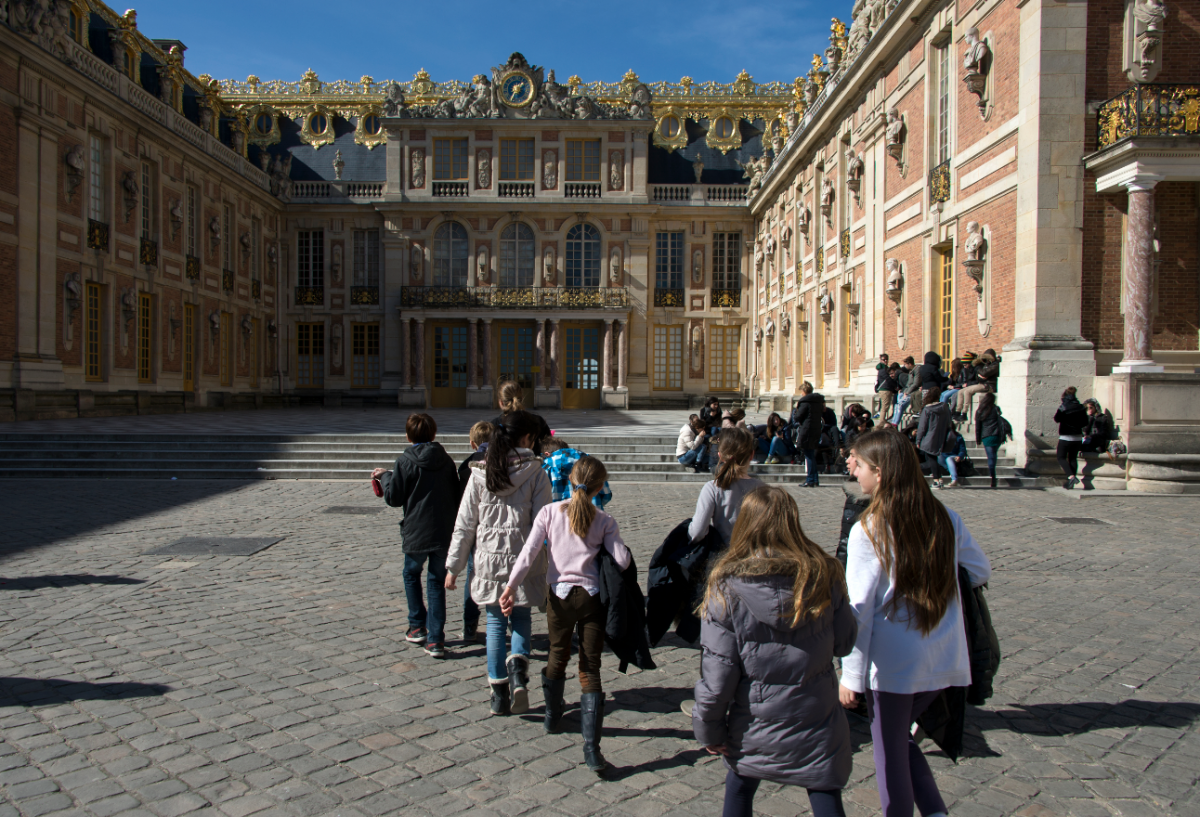
Since January 2017, the museum has offered special programming for high-priority groups (students, extracurricular groups, disabled people, and culturally excluded groups) on Mondays, when the museum is closed to the general public. Students and non-profit organisations thus have a special opportunity to see Versailles in a new light and discover the Palace’s diversity.
«"We believe in expanding access to the Palace of Versailles so this exceptional heritage can nourish everyone’s dreams." »
Catherine Pégard
President of the Palace, Museum and National Estate of Versailles
Accessible collections
Versailles « Live»
The use of digital tools is now essential to promoting Versailles' rich heritage to a broad audience, in France and around the world. In that vein, since 2015 the Palace has been working on a new videoconference model that is highly innovative and sophisticated in terms of technique and content, thanks to the skills-based sponsorship of Galaxie Groupe. These live, interactive videoconferences offer remote visits of the Palace, with an educator in a studio and a field reporter in the Palace rooms or gardens. Remote visitors can ask questions and even guide the camera if they wish.
Sensory tours of the Palace
The Palace of Versailles has designed a new tour invoking multiple senses: smell, hearing, sight, and touch. For the re-opening of the Coach Gallery in May 2016, a sensory tour included soundtracks (introduction by the Grand Equerry, Louis XVIII's funeral procession, etc.), tactile plates with audio-descriptions, and coaches that could be handled and taken apart.

As part of the Palace's Festivities and Entertainment at Court exhibition, from 29 November 2016 to 26 March 2017, special interpretive tools were created and integrated into the exhibition's scenography for use both by tour guides and the general public on self-guided visits. Audio-guided tours also ensured that visually deficient visitors could enjoy the exhibition’s main works.
Versailles « Beyond its Walls »
In addition to improving on-site accessibility, the Palace of Versailles has also developed a "Beyond the Walls" programme for people who cannot come to the museum, for legal or physical reasons. The Palace has established partnerships with prisons to provide lectures and thematic workshops to the prisoners participating in these programmes. Furthermore, thanks to the sponsorship of Fonds Handicap & Société, the Palace designed specific interpretative tools to be used for workshops in hospitals or retirement homes: scale models of mannequins and costumes, tactile plates reproducing the famous Portrait of Louis XIV in his Coronation Costume by Hyacinthe Rigaud, etc.
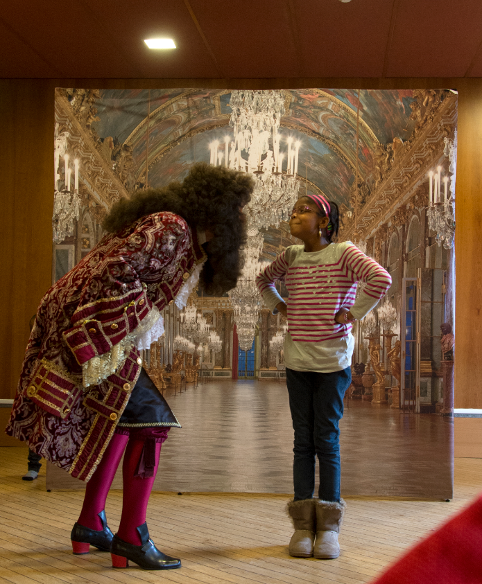
New Educational Workshops
Thanks to the support of Fondation Bettencourt Schueller, rooms in the South Wing of the Palace have been adapted and set aside for educational activities and exhibitions. This lively and colourful space is designed for children, families, and all those looking for a different experience of the museum and its collections. As a symbol of the Palace's openness to all its visitors, it will be accessible to everyone: school groups, the disabled, and those with little access to museums. It will include a family area, customisable studio-workshops, a lecture area, etc. With this new space, the Palace of Versailles seeks to double or even triple the number of people who participate in specific educational activities each year.
New Spaces in the South Wing
The workshops will be composed of 5 rooms able to accommodate 140 people at once, with three rooms dedicated to visual arts, practical work and digital activities, a room for corporal expression (dance, theatre, music) and a training room. part 3 The colours, shapes, materials and ergonomic design of the furniture and objects will create a space adapted to everyone. Participants will also be able to use digital resources to carry out activities (computers, Wi-Fi, etc.) and a materials library containing samples of materials used by artistic craftsmen (tortoiseshell used by cabinetmakers for marquetry, different colours and types of marble, pieces of gilded wood etc.) The spaces will be fully adjustable since their layout can be changed according to the activity, users and number of people to be accommodated (one large space or several smaller ones, possibility for tables, chairs, cushions etc.) They will also include all the necessary facilities for welcoming members of the public, such as a cloakroom, snack area, relaxation space and toilets.
A New Programme for Educational Workshops
The creation of these new spaces will allow the Palace of Versailles to develop its offering of educational activities for all audiences in an ambitious way, with a strong desire to strengthen knowledge of artistic professions and promote, support and transmit the related skills. Every visit to the former royal estate provides an opportunity to admire the expertise of the artistic craftsmen who made Versailles and who continue to do so today. The public Institution works daily in this sense by proposing a number of themed guided tours which showcase their work or by organising exceptional events on days dedicated to artistic professions or heritage. Thanks to these new spaces and through hands-on learning, meetings and conferences or digital culture tools (social networks, 3D technology etc.), the public will be able to draw closer to those who work to preserve heritage, as well as learning more about their patrimony and discover their ability for innovation.
Special events
Special events offer a great opportunity for visitors to discover or re-discover Versailles through festive or thematic initiatives. They also allow the Palace to provide high-priority audiences with original programming and activities that are adapted to their needs.
Theme Days
Each year, a theme day is organised for a non-profit organisation that partners with the FDJ company foundation, offering original activities that showcase different aspects of the Estate (introduction to dances, a falconry show, presentation of games from that time period, etc.). The FDJ company foundation also support the "Celebration for All" initiative in collaboration with the Red Cross, during which the Palace hosts more than 300 Red Cross beneficiaries (adults and children) for a day-long event towards the end of the year.
A Holiday at Versailles
As part of its sponsorship of the Olafur Eliasson Versailles exhibition, the Emerige Group worked with the Palace to create "A holiday in Versailles". In 2016, the Palace hosted almost 6,000 children ages 6 to 13 from the Ile-de-France region who weren't going on holiday.
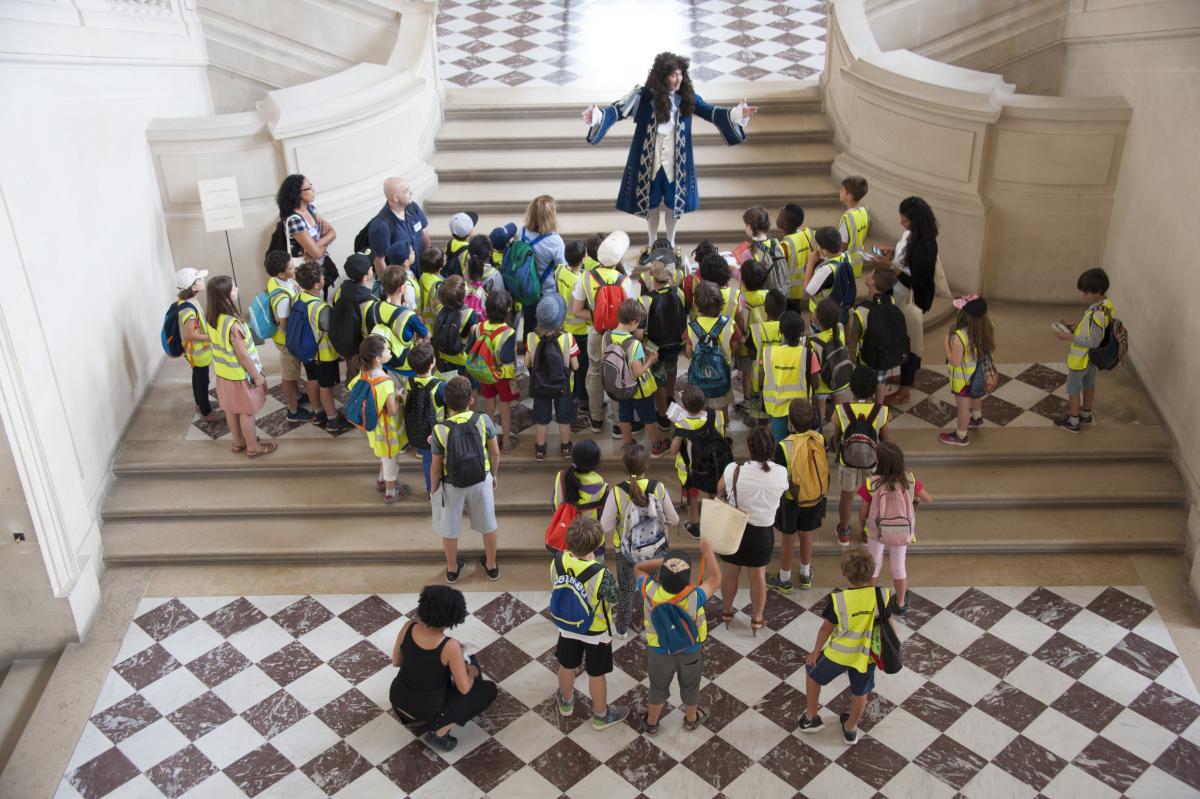
Activities for students from priority education networks
For the past 6 years, the Palace of Versailles has collaborated with Fondation Deloitte to invite around 350 people (children and their parents) from priority neighbourhoods in Ile-de-France for a special visit of the Versailles Estate each year.
Audiovisual Technology and Heritage
In 2016, Fondation France Télévisions joined the Palace of Versailles and Fondation Deloitte for an "Audiovisual Technology and Heritage" project. Secondary school pupils from Seine-Saint-Denis served as extras and technical assistants for a docudrama on Louis XIV, directed by students in the audiovisual professions at Suger vocational high school in Saint-Denis.
French Language Week
For the past several years, the Palace of Versailles has participated in the French Language and Francophonie week to reach newly arrived immigrants participating in language or literacy courses. In 2017, the programme was called "Versailles and Word Play: Theatre at Court", supported by Fondation Groupe RATP. From January to March 2017, the Palace offered visits and workshops on the topic of 17th century theatre to close to 200 participants from organisations that specialise in the reception and integration of new immigrants.
Disabilities Week
As part of the International Day of Persons with Disabilities on 3 December each year, and in partnership with the FDJ company foundation, the Palace of Versailles organises a Disabilities Week to showcase the different methods used to facilitate access for disabled visitors. For the fourth edition in 2016, more than 250 people participated in programming based on the Festivities and Entertainment at Court exhibition.
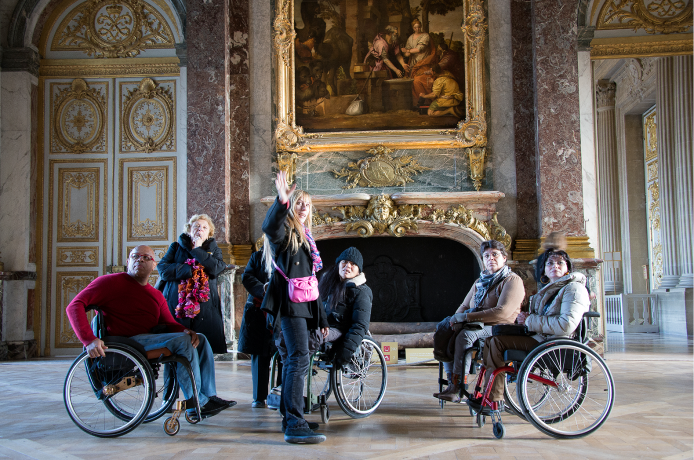
Not to Mention…
Heritage Week, Artistic Trades Week, Gardens Week, the Science Festival, "ApiDays", and "The Class, the Work", annual initiatives that allow school groups, special audiences, and families to discover the Palace and gardens in new ways.
Long-term Projects
2017 – 2019 : Demos
The Démos project seeks to expand access to culture by teaching children from disadvantaged areas without any prior musical training to play an instrument as part of group classical music lessons. Démos is a national programme that invites 3,000 children aged 7-13 to 30 orchestras across the country. The Philharmonie de Paris, which initiated the project, will host all the groups together for major final concert in 2019.
As part of this project, the Palace of Versailles is sponsoring 105 children from the Yvelines department, regularly organising visits and workshops for them. For three years, groups of 15 young musicians will take four hours of lessons each week, outside of school time, with musicians from the Orchestre de Paris or the Orchestre Symphonique Divertimento. On 16 June 2017, they give their first concert at the Great Stables, in the manège of the Equestrian Academy of Versailles.
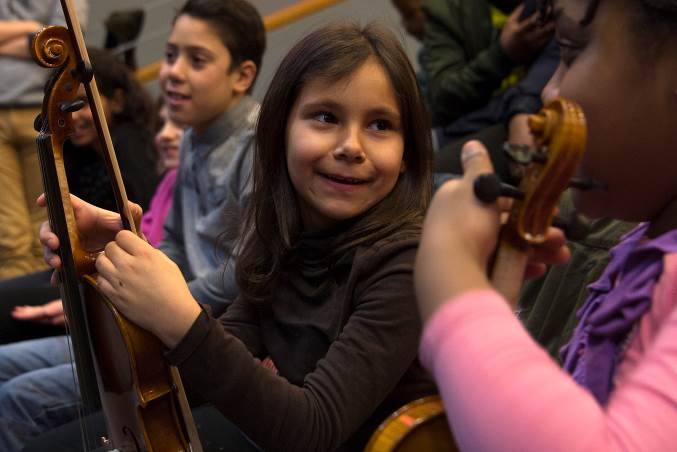
2017 – 2018 : Versailles choreographed
Thanks to the Ile-de-France Prefecture, and in collaboration with the towns of Les Mureaux and Ecquevilly, the Grand Paris Seine Oise Urban Community (CUGPSO), and the Académie de Versailles, the Palace of Versailles has established a partnership around the priority security zone of Les Mureaux to allow residents to discover Versailles through dance.
The "Versailles Dances" project explores parallels between baroque dance and dances from around the world through their symbolism, social aspects, and influences. With the help of artists and lecturers, in collaboration with local organisations, and with the support of Transdev, these residents will be able to "dance in Versailles".
2016 – 2017 : Stopover at Trianon
Following the success of the 2015 collaboration with the organisation Zig Zag Color, which led to an exhibition in the gardens of Versailles of works by a hundred or so autistic artists, the Palace has launched another project called "Stopover in Trianon". This project is supported by the Groupe EDF company foundation and by Fondation Terrévent.
In collaboration with Le Bel Air Medico-Educational Institute (MEI) in Le Chesnay, which cares for youth with disabilities and in difficult social and family circumstances, the goal of this initiative is to give these young people the opportunity to discover the Palace and develop an artistic practice. Their works will be exhibited in the Trianon gardens in May and June 2017.

2015 – 2016 : We can't see anything but…
During the 2015-2016 school year, the Palace of Versailles collaborated with the Académie de Versailles on a department-wide artistic and cultural education project for students from preschool to high school. Thanks to the support of Groupe MGEN, this initiative allowed students to discover the North Attic of the Palace, a gallery housing collections of 19th century paintings. More than 12,000 students were able to work with fragments of these paintings, which they transformed and used as inspiration to create an original artwork. The student creations were exhibited at the Palace of Versailles and at the Commanderie des Templiers in Élancourt. For the 2017-2018 school year, a new project will include students from primary and secondary schools in the Académie de Versailles.
2015 : Hippolyte et Aricie
Thanks to the support of Groupe MGEN, the Palace of Versailles collaborated with the Académie de Versailles and the Centre de Musique Baroque de Versailles to develop an artistic and cultural education programme focused on music and heritage, with performance as the theme. The programme included 370 students and teachers from 14 classes in primary and secondary schools in priority education zones and rural areas in Yvelines. Students were able to prepare ahead of the performance, and on 9 June 2015 attended the performance in the Gallery of Great Battles of La Belle-mère amoureuse, a parody of Rameau's Hippolyte et Aricie for singers and puppets, directed by Jean-Philippe Desrousseaux.
Become a Patron
Many of these initiatives would not have been possible without the support of our patrons, who are equally committed to making sure that culture is accessible, shared, and transmitted to everyone, regardless of their circumstances. A number of patrons thus work alongside the Palace to expand access to culture for all.
Whether you are an individual, company, or foundation, you can participate in an educational and socially responsible sponsorship project, and thus place humans at the heart of heritage.
Caroline Picard in the patronage department can help you choose your project.
+ 33 (0)1 30 83 84 49
caroline.picard@chateauversailles.fr
News
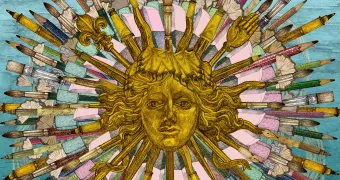
Instagram drawing contest
Instagram drawing contest #DessineMoiVersailles
From July 17 to September 17 2020, the Palace of Versailles is organizing a drawing contest on Instagram on the theme "draw me Versailles". You can participate by posting your drawings on your Instagram account, using the hashtag #DessineMoiVersailles.




